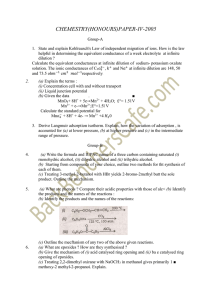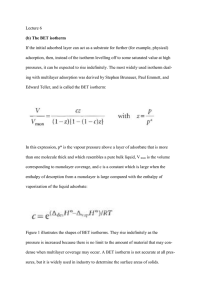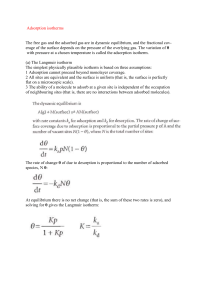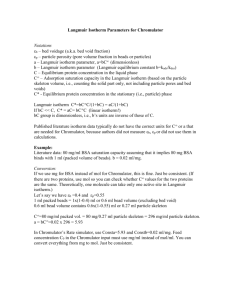Equilibrium sorption isotherm for Cu(II)
advertisement
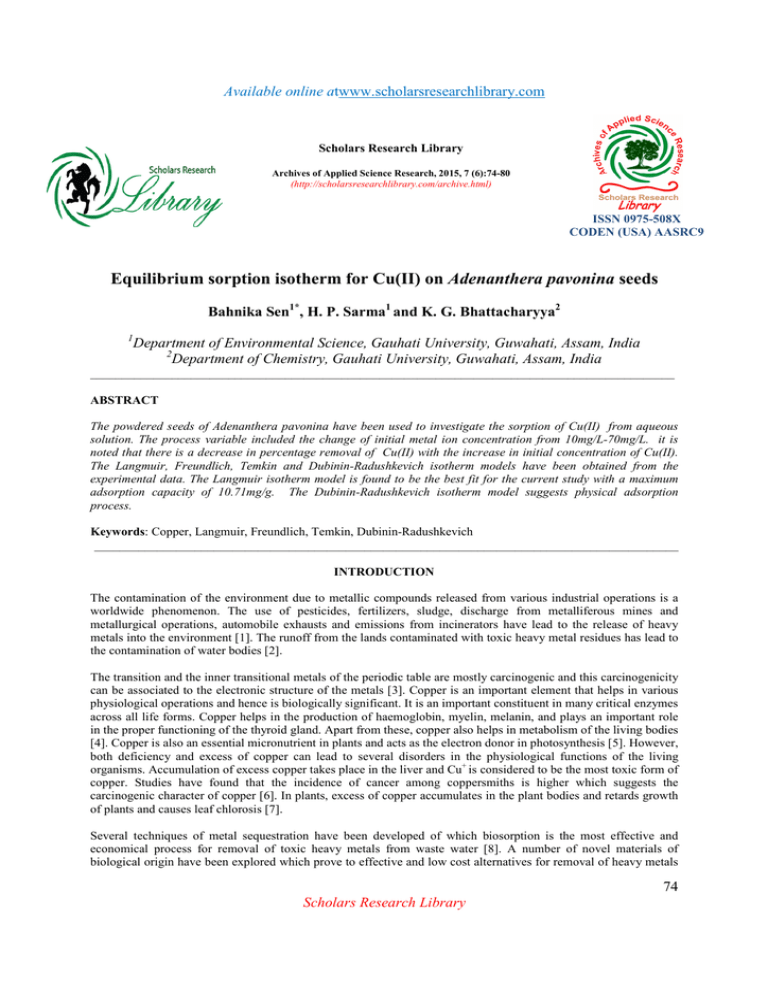
Available online atwww.scholarsresearchlibrary.com Scholars Research Library Archives of Applied Science Research, 2015, 7 (6):74-80 (http://scholarsresearchlibrary.com/archive.html) ISSN 0975-508X CODEN (USA) AASRC9 Equilibrium sorption isotherm for Cu(II) on Adenanthera pavonina seeds Bahnika Sen1*, H. P. Sarma1 and K. G. Bhattacharyya2 1 Department of Environmental Science, Gauhati University, Guwahati, Assam, India 2 Department of Chemistry, Gauhati University, Guwahati, Assam, India _____________________________________________________________________________________________ ABSTRACT The powdered seeds of Adenanthera pavonina have been used to investigate the sorption of Cu(II) from aqueous solution. The process variable included the change of initial metal ion concentration from 10mg/L-70mg/L. it is noted that there is a decrease in percentage removal of Cu(II) with the increase in initial concentration of Cu(II). The Langmuir, Freundlich, Temkin and Dubinin-Radushkevich isotherm models have been obtained from the experimental data. The Langmuir isotherm model is found to be the best fit for the current study with a maximum adsorption capacity of 10.71mg/g. The Dubinin-Radushkevich isotherm model suggests physical adsorption process. Keywords: Copper, Langmuir, Freundlich, Temkin, Dubinin-Radushkevich _____________________________________________________________________________________________ INTRODUCTION The contamination of the environment due to metallic compounds released from various industrial operations is a worldwide phenomenon. The use of pesticides, fertilizers, sludge, discharge from metalliferous mines and metallurgical operations, automobile exhausts and emissions from incinerators have lead to the release of heavy metals into the environment [1]. The runoff from the lands contaminated with toxic heavy metal residues has lead to the contamination of water bodies [2]. The transition and the inner transitional metals of the periodic table are mostly carcinogenic and this carcinogenicity can be associated to the electronic structure of the metals [3]. Copper is an important element that helps in various physiological operations and hence is biologically significant. It is an important constituent in many critical enzymes across all life forms. Copper helps in the production of haemoglobin, myelin, melanin, and plays an important role in the proper functioning of the thyroid gland. Apart from these, copper also helps in metabolism of the living bodies [4]. Copper is also an essential micronutrient in plants and acts as the electron donor in photosynthesis [5]. However, both deficiency and excess of copper can lead to several disorders in the physiological functions of the living organisms. Accumulation of excess copper takes place in the liver and Cu+ is considered to be the most toxic form of copper. Studies have found that the incidence of cancer among coppersmiths is higher which suggests the carcinogenic character of copper [6]. In plants, excess of copper accumulates in the plant bodies and retards growth of plants and causes leaf chlorosis [7]. Several techniques of metal sequestration have been developed of which biosorption is the most effective and economical process for removal of toxic heavy metals from waste water [8]. A number of novel materials of biological origin have been explored which prove to effective and low cost alternatives for removal of heavy metals 74 Scholars Research Library Bahnika Sen et al Arch. Appl. Sci. Res., 2015, 7 (6):74-80 ______________________________________________________________________________ from wastewater [9]. In the present study, the authors have aimed at studying the removal of Cu (II) from aqueous solutions using powdered Adenanthera Pavonina seeds. The study was conducted at different initial concentration of Cu(II) and the isotherm constants for Langmuir, Freundlich, Temkin and Dubinin-Radushkevich isotherm models have been determined. MATERIALS AND METHODS The primary aim of the current study is to investigate the sorption of Cu(II) on powdered Adenanthera pavonina seeds which is found naturally in Bongaigaon district (Assam,India). These seeds are collected, washed thoroughly with distilled water, air dried and crushed mechanically. The powdered seeds are sieved to 250 µm ,dried again and stored in air tight containers to be used as such for future experiments without any pre-treatments. Analytical grade reagents are used in all experiments. Stock solution of Cu(II) (1000 mg/L) is prepared by dissolving 3.802g of Cu(NO3)2. 3H2O in 1000mL of distilled water. Adequate dilution of the stock solution using distilled water is done to prepare working solutions of different initial concentrations (10-70mg/L). Batch experiments are conducted at a constant temperature of 320C, agitated for 40 minutes on an orbital shaker at 120 rpm with a fixed adsorbent dose of 0.5g in 100mL of working solution capped in 250mL conical flasks. The pH of the working solution is fixed at 5, using 0.1 N HNO3 or 0.1N NaOH. After agitated for the said fixed duration, the mixture is filtered through Whatman 41 filter paper, and the filtrate is analyzed using Atomic Absorption Spectrophotometer (AAS) for the concentration of Cu(II) after adsorption. The percentage removal of Cu(II) can be calculated using the following expression: %RemovalofCu(II) = ( ) × 100 (1) Where, Cinitial, Cfinal denotes the initial and final concentrations of Cu(II) in mg/L. The metal uptake, qe, at equilibrium is calculated from the equation q = ( ) ×V (2) Where qe is the adsorption capacity in mg/g, C0 and Ce are the initial and equilibrium concentrations of Cu(II) in mg/L. V represents the volume of Cu(II) solution, in L, and W is the total amount of powdered Adenanthera pavonina seeds in grams. For designing the sorption systems, the equilibrium sorption isotherm models play the fundamental role. The constants that are characteristic of the sorption isotherm model express the surface properties and affinity of the sorbent. The isotherm models are also helpful in analyzing certain equilibrium relationships like the ratio between the quantity of sorbate already sorbed and the quantity remaining in the in the solution under constant temperature at equilibrium [10]. In the present study, four isotherm models have been studied. These are Langmuir isotherm [11], Freundlich isotherm [12], Temkin isotherm [13], and Dubinin-Radushkevich isotherm [14]. RESULTS AND DISCUSSION The present study investigates the equilibrium sorption isotherms for Cu(II) on powdered Adenanthera pavonina seeds. The effect of initial metal ion concentration and the evaluation of isotherm constants from isotherm equations are discussed in the following paragraphs. 1.1 Effect of initial concentration: The initial Cu(II) concentration, in the present study, varied from 10-70 mg/L. It is seen that, with the increase in Cu(II) concentration from 10-70mg/L, the percentage removal decreases from 93%-65% and the adsorption capacity increases from 1.88 mg/g to 9.16 mg/g (Figure 1). The ratio between the number of moles of Cu(II) ions and the number of sites available for adsorption is low at lower concentrations. As a result, the initial metal ion concentration had no influence on the fractional adsorption. At higher initial metal ion concentration, the number of available adsorption sites decreases as compared to the number of moles of metal ions in the adsorption system. 75 Scholars Research Library Bahnika Sen et al Arch. Appl. Sci. Res., 2015, 7 (6):74-80 ______________________________________________________________________________ Thus percentage removal of metal ions from the aqueous solution is influenced by the initial metal ion concentration [15]. 10 % Removal of Cu(II) 95 8 90 85 6 80 4 75 70 2 65 60 Adsorption Capacity (mg/g) 100 % Removal of cu(II) Adsorption Capacity 0 0 20 40 60 80 Initial Cu(II) Concentrations Figure1: Effect of initial Cu(II) concentration on Cu(II) uptake 3.2 Langmuir isotherm: The Langmuir isotherm model has been efficiently applied in many contaminant sorption systems and is the most widely used isotherm model for sorption of solute from an aqueous solution. The Langmuir theory assumes that monolayer adsorption takes place at specific homogenous sites within the adsorbent. The isotherm equation is in the form of Equation (3): "= # #$ = % (3) &' Where, b is Ka/Kd (Ka and Kd are rate constants for adsorption and desorption respectively) (L/mg), qe (mg/g) is the amount adsorbed on unit mass of the adsorbent, qm (mg/g) is the saturated monolayer sorption capacity and Ce (mg/L) is the equilibrium concentration. A dimensionless equilibrium parameter RL also known as separation factor has been developed on the basis of the Langmuir equation [16]. () = & (4) &'% The value of RL should be 0<RL<1 for favorable adsorption, while RL>1 represents the unfavorable adsorption, RL=1 represents linear adsorption and RL=0 represents irreversible adsorption process. The linearized equation for Langmuir isotherm model is as follows: * & = + + # ,- /,- (5) The values of Qm and b are calculated from the slope and intercept of the plot of Ce/qe versus Ce (Figure 2). 76 Scholars Research Library Bahnika Sen et al Arch. Appl. Sci. Res., 2015, 7 (6):74-80 ______________________________________________________________________________ 3 2.5 Ce/qe 2 1.5 1 0.5 0 0 5 10 15 20 25 30 Ce . Figure 2. Langmuir isotherm of Cu(II) adsorbed on powdered A.pavonina seeds The Langmuir constant Qm (Qmax) is found to be 10.71 mg/g where as adsorption energy ‘b’ is calculated as 0.189 L/g (Table 1). The R2 value is found to be 0.9847, which is higher than the other three isotherm models analyzed in the current study. The RL value lies in the range of 0.07 to 0.35 which satisfies 0<RL<1. This denotes favorable adsorption process for Cu(II) on powdered Adenanthera pavonina seeds. 3.3 Freundlich isotherm: The Freundlich isotherm model suggests that if the equilibrium concentration of solute in the solution, Ce, is raised to the power of 1/n, with qe as the amount of solute adsorbed, then Ce1/n/qe is constant at a given temperature [12]. The isotherm model can be expressed empirically by the following equation. 01 = 23 415 (6) The linear equation for Freundlich isotherm is expressed as log q = 7 log C + log K9 (7) Where, Kf is the Freundlich constant indicating the relative adsorption capacity of the adsorbent, n is the Freundlich coefficient representing the deviation from linearity of adsorption. Kf and n can be calculated from the plot of log qe versus log Ce (Figure 3). 1.2 1 logqe 0.8 0.6 0.4 0.2 0 -0.5 0 0.5 1 1.5 logCe . Figure 3. Freundlich isotherm of Cu(II) adsorbed on powdered A.pavonina seeds Table 1 shows the calculated values of Kf and n, which are found to be 2.44 mg/g and 0.41 (0<n<1) which shows favorable adsorption. 77 Scholars Research Library Bahnika Sen et al Arch. Appl. Sci. Res., 2015, 7 (6):74-80 ______________________________________________________________________________ 3.4 Temkin isotherm: The Temkin isotherm model suggests that the heat of adsorption falls linearly rather than logarithmically as suggested by the Freundlich equation. The equation for Temkin isotherm model is expressed as follows. 01 = :; /< ln(A? C ) (8) The Equation (8) can be linearized as given by Equation (9): q = @; ln A? + B? ln C (9) Where, BT = (RT)/bT, T is the absolute temperature in K and R is the universal gas constant (8.314J/molK). The constant bT denotes the heat of adsorption, AT is the binding constant (L/min) which corresponds to the maximum binding energy. The slope and intercept from the plot of qe versus log Ce (Figure 4) gives the values for the Temkin isotherm constants, AT and bT which are found to be 123.33 L/g and 0.953 respectively (Table 1). A regression correlation coefficient, R2, of 0.9657 is obtained, which shows that the Temkin isotherm model is a better fit than the Freundlich isotherm model but less suitable than the Langmuir isotherm model. 10 lnCe 8 6 4 2 0 -0.5 0 0.5 1 1.5 qe .. Figure 4. Temkin isotherm of Cu(II) adsorbed on powdered A.pavonina seeds 3.5 Dubinin-Radushkevich isotherm: The Dubinin-Radushkevich isotherm model can be expressed by the following equation. ln q = ln qB − @D E F (10) Where, ,qD is the maximum adsorption capacity (mg/g), BD (mol2/J2) is the constant related to sorption energy [17] and ε2 can be calculated from equation (11) E = (G ln H1 + & *+ I (11) Where R is universal gas constant (J/K mol) and T is the absolute temperature in Kelvin (K) The mean energy of adsorption is calculated from the Equation (12) & JD = KFLM (12) The D-R isotherm constants, qD and BD are calculated from the plot between ln qe and ε2 (Figure 5) The maximum adsorption capacity, qD is found to be 6.55 mg/g which is lower than that found in the Langmuir isotherm model where it was found to be 10.71 mg/g. A BD value of 2X10-7 mol2/J2 is also calculated from the above model. The regression coefficient is found to be of 0.7782, which shows that the Dubinin-Radushkevich isotherm is a less suitable fit as compared to the other three isotherm models studied. 78 Scholars Research Library Bahnika Sen et al Arch. Appl. Sci. Res., 2015, 7 (6):74-80 ______________________________________________________________________________ The ED value suggests whether the adsorption is physical or chemical in nature. When ED values lie in the range of 1-8 kJ/mol physical sorption prevails while values within the range of 9-16 kJ/mol indicate that the process is chemisorption [18]. In the present study, ED is found to be, 1.58 kJ/mol, which clearly states that physical adsorption governs the process. 2.5 2 lnqe 1.5 1 0.5 0 0 1000000 2000000 3000000 4000000 5000000 6000000 ε2 . Figure 5. D-R isotherm of Cu(II) adsorbed on powdered A.pavonina seeds CONCLUSION The above study suggests that the adsorption of Cu((II) on powdered Adenanthera pavonina seeds is affected by the initial metal ion concentration. It is noted that with the increase in concentration the percentage adsorption decreases where as there is an increase in the adsoptive capacity of the adsorbent. The results obtained from the experiments are analyzed using Langmuir, Freundlich, Temkin and Dubinin-Radushkevich isotherm equations. The correlation coefficient for Langmuir isotherm model is significantly better than the other three isotherm models studied. Moreover, the Langmuir model gives a maximum adsorption capacity of 10.71 mg/g. The Dubinin-Radushkevich model suggests that the system follows physical adsorption. Thus it can be stated that Cu(II) adsorption is favorable using powdered Adenanthera pavonina seeds. Acknowledgment The authors like to thank INSPIRE (DST), for their financial support. Head, Department of Environmental Science (Gauhati University) and Head, Department of Chemistry (Gauhati University) are also greatly thanked. REFERENCES [1] C. Garbisu, I. Alkorta, European Journal of Mineral Processing and Environmental Protection, 2003,13, 58-66 [2] R.Reza, G.Singh, G, International Journal of Environmental Science and Technology , 2010,7(4), 785-792 [3] Y.S.Ho, C.T.Huang, H.W.Huang, Process Biochemistry,2002,37, 1421-1430 [4] J.Osredkar, N.Sustar, Journal of Clinical Toxicology, 2011,S3:001 [5] W.Maksymiec, Photosynthetica, 1997, 34(3), 321-342 [6] T.D. Luckey, B.Venugopal, Metal toxicity in mammals. Physiologic and Chemical Basis for Metal Toxicity, Plenum Press, New York, 1977, 1, 238 [7] S.Lewis, M.E.Donkin, M.H.Depledge, Aquatic Toxicology, 2001, 51, 277–291. [8] A.A.Abia, Jr M.Horsfall, O.Didi, Bioresource Technology, 2003, 90(3), 345-348 [9] S.E.Bailey, T.J. Olin, R.M. Bricka, D.Adrian, Water Research, 1999, 33(11), 2469-2479 [10] Y.S.Ho, C.T.Huang, H.W.Huang, Process Biochemistry, 2002, 37, 1421-1430 [11] I. Langmuir, Journal of American Chemical Society, 1916, 38(11), 2221-2295 [12] H.M.F. Freundlich, The Journal of Physical Chemistry, 1906, 57A, 385–470. [13] X.C .Fu, W.X. Shen, T.Y.Yao, Physical Chemistry, Higher Education Press, Beijing, 1994, 4, 303–321. 79 Scholars Research Library Bahnika Sen et al Arch. Appl. Sci. Res., 2015, 7 (6):74-80 ______________________________________________________________________________ [14] M.M. Dubinin, Chemical Reviews, 1960, 60(2), 235–266. [15] S.Dahiya, R.M.Tripathi, A.G. Hegde, Bioresource Technology, 2008, 99, 179–187 [16] K.R.Hall, L.C.Eagleton, A. Acrivos, T. Vermeulen, Industrial Engineering Chemistry Fundamentals, 1966, 5,212-219 [17] M.B.Ibrahim, S.Sani, Open Journal of Physical Chemistry ,2014,4, 139-146. [18] M.Jain, V.K. Garg, K. Kadirvelu, Journal of Hazardous Materials, 2009, 162(1), 365–372 . 80 Scholars Research Library
